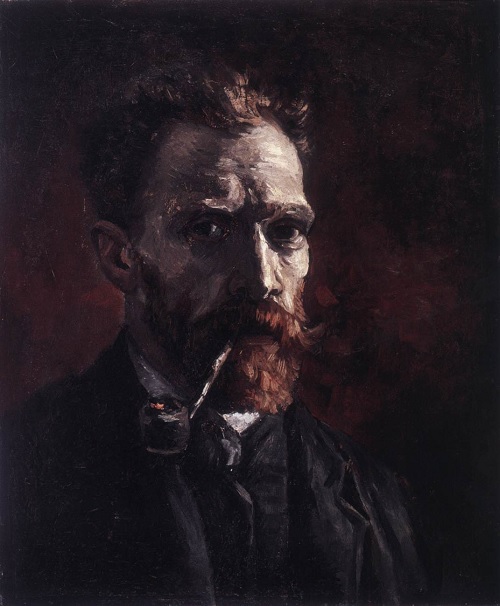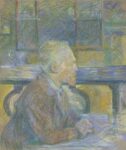
Vincent Van Gogh
Dutch, 1853-1890 (active France)
Self-Portrait with Pipe, 1886
oil on canvas
Van Gogh Museum, Amsterdam, Vincent Van Gogh Foundation

Toulouse-Lautrec – Portrait of Vincent Van Gogh, 1887
"I lately did two heads, which I dare say are better in light and color than those I did before. So as we said at the time in COLOR seeking LIFE, the true drawing is modelling with color." - Letter to Horace Mann Livens, September or October 1886
COMMENTS
Van Gogh painted himself very often: in Paris alone more than 20 times. Every time he looks different. The self-portraits were for him an exercise in portraying. He experimented with facial expression, color and shape.
In Paris, Van Gogh had been introduced to the work of Adolphe Monticelli (1824-1886). He admired this older French painter for his rich color palette and thick paint.
In this self-portrait he tried to apply Monticelli's use of color and light effects. The pale tones of his face stand out sharply against the warm, dark red background.
- Van Gogh Museum, Amsterdam, 2021
Van Gogh painted almost 230 paintings during his stay in Paris, more than in any other comparable period in his life. This work is more diverse in character, the frank record of two years of continual experiment. In Paris, van Gogh put the rootedness of his apprentice years behind him. In terms of energy, what he accomplished is amazing; though of course speed, and ingenious touches, could not be as important as steady work. The theories van Gogh had adumbrated in the last letters he had written from Nuenen were still far from being visible in his practice, and he was to spend the whole of 1886 putting the finishing touches to his early work. It took him several months before he could launch off in a new artistic direction. Van Gogh was still travelling with a good deal of the baggage he had picked up as he started on the artist’s life, and could not simply throw it away in his new milieu. The main features of his Dutch output remained.
Those features might be characterized, in a word, as “realistic”. Realism was a label that covered a multitude of artistic approaches, and still is; but, vague as the term may be, it can be helpful in trying to assess the diversity of van Gogh’s oeuvre. Realism implies first and foremost a willingness to trust what is out there, what can be seen by the eye in everyday life. …
In the mid-19th century, the sociopolitical pathos of Courbet and his disciples had made realism a programmatic position. The artist’s eye was merciless; the reality he saw was rendered without any prettifying. Art took the side of the awkward angles of life that academic ornamentalism had smoothed out of existence. The new heroes were workers, beggars, and all the have-nots – the masses who had been given worthy literary treatment in Victor Hugo’s “Les Miséables” for the first time. The Realist School (so said their principal propagandist Jules-Antoine Castagnary) “sees Art as an expression of every aspect and every level of Life; its pre-eminent aim is to reproduce the power and vividness of Nature as forcefully as possible; it is Truth allied to Knowledge. Through its interest in rural life (which it has already proved able to present strikingly) and city life (which promises triumphs for the future), it is attempting to encompass every aspect of the visible world. In placing the artist squarely at the heart of his times and requesting him to mirror them, it is defining the true meaning and thus the moral mission of Art.”
The same moral earnest[ness], the same emphatic directness, was apparent in the manifesto van Gogh had already painted, “The Potato Eaters”. Ugliness was a token of involvement, expressive élan a means of locating the truth. Some of the best works done in his Dutch period show van Gogh to have been a committed realist. His devotion to the soil and above all to the simple, careworn people who lived off the land, and their poor homes, was essential to the dignity that is in these portraits and interiors. …
If realism meant mimetic imitation of the given world of phenomena, and was by extension an aesthetic program, the concept also embraced a third area: a method of direct approach to objects, a certain immediacy in the painter’s confrontation of his subject. Realism, in this sense of an artistic method, remained van Gogh’s watchword after he moved to the city. Seen in these terms, his entire output of 1886 was realistic. …
Van Gogh’s “realism” peaked in his first Paris phase. And it was only because he had grown confident of his command that he was able to shrug off virtuoso technique in the way he did in the years ahead. …
In Nuenen he had written of “creating in peace and quiet using only the palette, and Nature is in agreement”. Yet in 1886 he did nothing of the kind. His colors remained far from the autonomy he had envisaged; indeed, van Gogh still abided faithfully by local color, by the appearance of his subject. His first self-portraits indulged in browns reminiscent of the old masters, without a single highlight of pure, forthright color to enliven them. It was as if the fascination of his own face crowded out all possibility of experiment with color. …
Van Gogh might have started improvising freely from the palette, adding color for its own sake, were it not for a figure of authority who confirmed him in his attachment to the subject: Adolphe Monticelli. Monticelli was a French painter of Italian extraction. His pictures of flowers were extremely pastose. And he was van Gogh’s first artistic discovery in Paris; Vincent was to value Monticelli till the end of his days. Theo and Vincent owned one or two of the Provençal artist’s impetuously painted canvases, works which made Vincent’s own brushwork look tame. But Monticelli, of course, was painting mimetic copies of flowers, even trying to use thick paints as a kind of relief to convey the tactile, physical dimension of his subject as well as the visual. “I have been trying to convey the intensity of color”, van Gogh wrote, referring to the flower still lifes. That was precisely it. The work he painted in 1886 was out to “convey”; it was still looking for (and in need of) the corrective reality would supply.
- Ingo F. Walther and Rainer Metzger, Vincent van Gogh; The Complete Paintings, Taschen, 2006, 241-260
SBMA CURATORIAL LABELS
Before his arrival in Paris in late February 1886, Van Gogh had never painted a self-portrait, likely because he did not possess a mirror, which this exercise obviously requires. Theo’s apartment, which also served as Vincent’s studio, was equipped with one, and Van Gogh would avail himself of it to paint some thirty self-portraits during his two years in Paris. This one, done in the fall of that year, does not yet reflect the increasingly experimental and higher keyed palette of the transitional Paris period work. The thirty-three-year-old artist regards his reflection calmly. He is neatly groomed, attired in a well-tailored suit, and smoking a pipe. He looks every bit the part of a sophisticated expat, discovering the cultural riches of Paris.
- Through Vincent's Eyes, 2022
